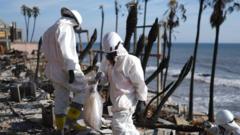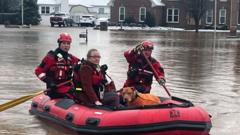**Scientists assert that while patterns of seismic activity can be observed, accurately predicting specific earthquakes in terms of time, location, and magnitude is not feasible with current technology.**
**The Challenge of Earthquake Predictions: Understanding Their Failures**

**The Challenge of Earthquake Predictions: Understanding Their Failures**
**Exploring why predicting earthquakes remains an elusive goal despite rising public interest and anecdotal forecasts.**
The quest for earthquake predictions often leads to frustration, as remarkable claims arise from various self-proclaimed seismologists. In recent months, Brent Dmitruk gained attention by predicting an earthquake near Eureka, California, only to see a significant quake hit the region later. As his following grows, so do questions about the accuracy of such forecasts.
However, experts like seismologist Lucy Jones emphasize the inherent unpredictability of earthquakes. Published studies indicate that while hundreds of thousands of tremors occur globally each year, forecasting their precise time and location remains unattainable. This unpredictability fuels anxiety among residents on the U.S. West Coast, who live under the looming threat of significant earthquakes.
The Mendocino Triple Junction, where three tectonic plates converge, is a hotspot for seismic activity, making predictions regarding the Eureka area less astounding. According to Jones, this type of educated guess is merely a speculative shot rather than a reliable forecast, given that the region has a history of tectonic movements.
While scientists can calculate probabilities of earthquakes in specific locales over decades, they clarify that such measurements offer little comfort to those seeking immediate safety guarantees. The challenge lies in the complex geological factors that lead to an earthquake. Understanding that stress builds along fault lines can explain why an earthquake occurs, yet predicting the precise moment of release remains beyond reach.
Predictors, like Dmitruk, who posit a higher magnitude earthquake yet fail to provide definitive timelines mislead followers. As Jones points out, consistent predictions can yield coincidental successes that unwittingly bolster false confidence. Dmitruk's claims of an imminent 10.3 magnitude earthquake, although vivid, remain unfulfilled as the mystery of seismic activity continues.
Although anticipation cannot dictate timing, preparation is crucial. Programs like the Great Shake Out exemplify the proactive measures individuals can take. The annual drill not only teaches proper safety techniques but also fosters community resilience against potential disasters. ShakeAlert, the U.S. Geological Survey's alert system, provides crucial seconds of warning, demonstrating the effectiveness of early detection without pinpointing exact occurrences.
As individuals confront the fact that earthquakes cannot be precisely predicted, they are urged to embrace preparedness methodologies that reduce risk and foster responsive actions when tremors inevitably strike. Ultimately, crafting a culture of readiness, rather than relying on potentially hollow predictions, could serve as the most effective means of mitigating earthquake-related perils in the future.




















